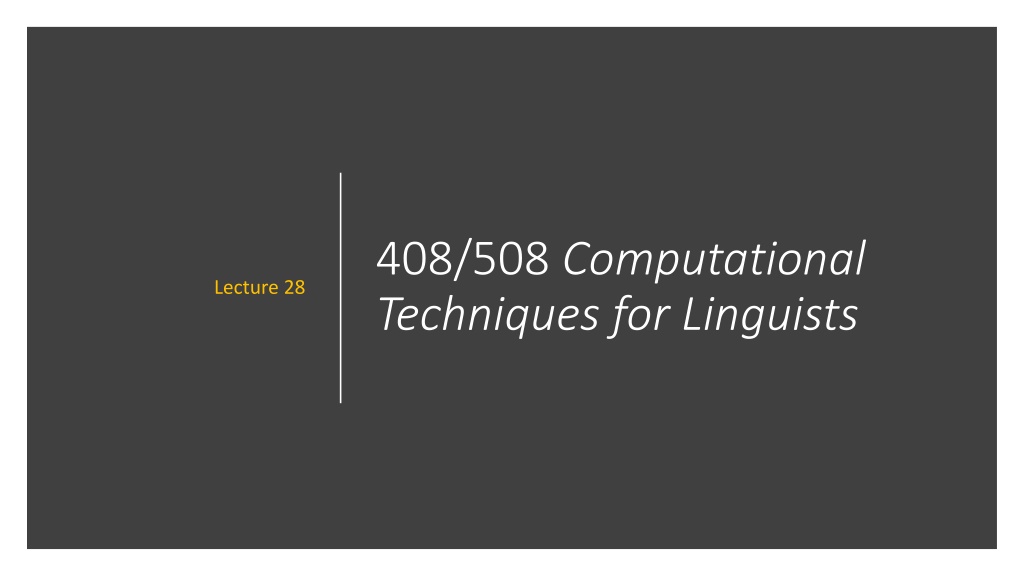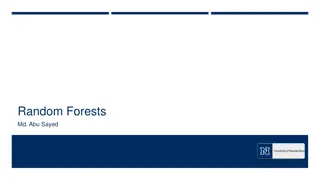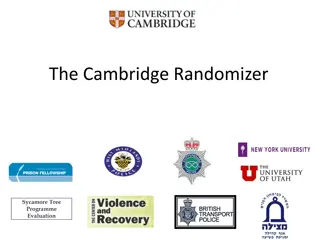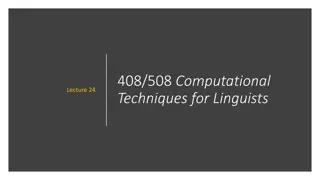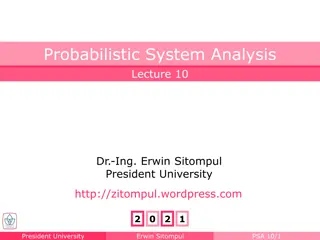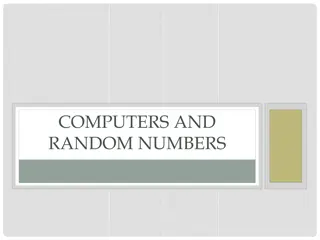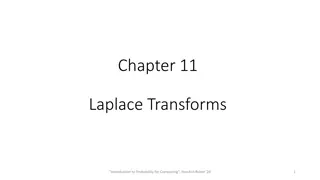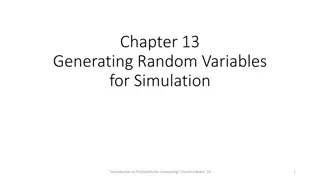Understanding Bigrams and Generating Random Text with NLTK
Today's lecture in the Computational Techniques for Linguists course covered the concept of bigrams using NLTK. Bigrams are pairs of words found in text, which are essential for tasks like random text generation. The lecture demonstrated how to work with bigrams, including examples from the NLTK book on generating random text using bigrams from the Genesis text. By analyzing bigrams and unigrams, linguists can gain insights into the structure and patterns of language.
Download Presentation

Please find below an Image/Link to download the presentation.
The content on the website is provided AS IS for your information and personal use only. It may not be sold, licensed, or shared on other websites without obtaining consent from the author. Download presentation by click this link. If you encounter any issues during the download, it is possible that the publisher has removed the file from their server.
E N D
Presentation Transcript
408/508 Computational Techniques for Linguists Lecture 28
Reminder You should be working on your term project Short write-up etc. due end of next week Please fill out the course survey!
Today's Topic We've seen nltk.FreqDist(words) previously counts how many times each word appears in words Conditional Frequency Distributions nltk.ConditionalFreqDist(tuples) Pairs of words: list of tuples (word1, word2) Bigrams n-gram: n = 2, bigram is a sequence word1 word2 in text n = 3, trigram is word1 word2 word3 in text Application: Random Text Generation
Bigrams NLTK Book 2.4 Generating Random Text with Bigrams >>> import nltk >>> from nltk.corpus import genesis >>> genesis <PlaintextCorpusReader in '.../corpora/genesis' (not loaded yet)> >>> g = genesis.words('english-kjv.txt') >>> len(g) 44764 >>> g[:30] ['In', 'the', 'beginning', 'God', 'created', 'the', 'heaven', 'and', 'the', 'earth', '.', 'And', 'the', 'earth', 'was', 'without', 'form', ',', 'and', 'void', ';', 'and', 'darkness', 'was', 'upon', 'the', 'face', 'of', 'the', 'deep']
Bigrams Unigrams (simple list of words): ['In', 'the', 'beginning', 'God', 'created', 'the', 'heaven', 'and', 'the', 'earth', '.', 'And', 'the', 'earth', 'was', 'without', 'form', ',', 'and', 'void', ';', 'and', 'darkness', 'was', 'upon', 'the', 'face', 'of', 'the', 'deep'] Bigrams (list of tuples (word1, word2)): [('In', 'the'), ('the', 'beginning'), ('beginning', 'God'), ('God', 'created'), ('created', 'the'), ]
nltk.bigrams() >>> bigrams = nltk.bigrams(g) >>> bigrams <generator object bigrams at 0x11d540200> >>> b = list(bigrams) >>> len(b) 44763 >>> b[:30] [('In', 'the'), ('the', 'beginning'), ('beginning', 'God'), ('God', 'created'), ('created', 'the'), ('the', 'heaven'), ('heaven', 'and'), ('and', 'the'), ('the', 'earth'), ('earth', '.'), ('.', 'And'), ('And', 'the'), ('the', 'earth'), ('earth', 'was'), ('was', 'without'), ('without', 'form'), ('form', ','), (',', 'and'), ('and', 'void'), ('void', ';'), (';', 'and'), ('and', 'darkness'), ('darkness', 'was'), ('was', 'upon'), ('upon', 'the'), ('the', 'face'), ('face', 'of'), ('of', 'the'), ('the', 'deep'), ('deep', '.')]
nltk.ConditionalFreqDist() Summary: nltk.ConditionalFreqDist() takes as input a bigram corpus (actually a list of (word1,word2) tuples) produced by nltk.bigrams(text) Usage: cfd = nltk.ConditionalFreqDist(nltk.bigrams(text)) cfd[word1] returns a nltk.FreqDist for word2. Example: >>> cfd = nltk.ConditionalFreqDist(b) >>> cfd['In'] FreqDist({'the': 9, 'my': 2, 'thee': 1}) cfd[word] gives a count dict of which words can follow word
nltk.ConditionalFreqDist() Case sensitive: the vs. The >>> cfd['The'] FreqDist({'sons': 5, 'children': 4, 'LORD': 4, 'man': 3, 'days': 2, 'three': 2, 'name': 1, 'woman': 1, 'serpent': 1, 'earth': 1, ...}) >>> cfd['the'] FreqDist({'land': 156, 'LORD': 154, 'earth': 105, 'sons': 69, 'name': 42, 'field': 39, 'men': 36, 'man': 34, 'waters': 30, 'children': 30, ...}) cfd[word].N() tells us the size (total # words in the corpus) that can follow word: >>> cfd['the'].N() 2411 >>> cfd['The'].N() 50
nltk.ConditionalFreqDist() cfd[word1].max() tells us what word is most likely to follow word1. >>> cfd['In'].max() 'the' cfd[word1].N() tells us the size (total # words in the corpus) that can follow word1. >>> cfd['In'].N() 12 cfd[word1].keys() gives the keys to the count dict; i.e. list of words that can follow word1. >>> cfd['In'].keys() dict_keys(['the', 'my', 'thee']) cfd[word1][word2] gives the number of times word2 can follow word1.
nltk.ConditionalFreqDist() cfd[word1][word2] gives the number of times word2 can follow word1. >>> cfd['The']['name'] 1 >>> cfd['The']['sons'] 5
NLTK Book: Chapter 2 File: nwords.py def next_word(w): return choice([k for k in cfd[w].keys() for i in range(cfd[w][k])]) def nwords(n, w): for i in range(n): print(w, end=' ') w = next_word(w) print() python -i nwords.py >>> nwords(5, 'The') The field , by two >>> nwords(5, 'The') The sons of many colours >>> nwords(5, 'The') The sons ' wives , >>> nwords(5, 'The') The sons of Haran ;
NLTK Book: Chapter 2 def next_word(w): return choice([k for k in cfd[w].keys() for i in range(cfd[w][k])]) Function explained: >>> cfd['beginning'] FreqDist({'of': 2, ',': 1, '.': 1, 'God': 1}) NB. Python 3.6 has a function called choices() >>> cfd['beginning'].keys() dict_keys(['God', 'of', '.', ',']) >>> cfd['beginning']['God'] 1 >>> cfd['beginning']['of'] 2 >>> [k for k in cfd['beginning'].keys() for i in range(cfd['beginning'][k])] ['God', 'of', 'of', '.', ','] random.choice(seq) Return a random element from the non-empty sequence seq. If seq is empty, raises IndexError.
NLTK Book: Chapter 2 1000 trials: 580 heads Expected number of heads? 600 Since 3 out of 5 in ['heads','heads','tails','heads','tails' ] are heads
NLTK Book: Chapter 2 def nwords(n, w): i in range(5) w for i in range(n): print(w, end=' ') w = next_word(w) print() >>> nwords(5,'The') The purchase of the LORD 0 The 1 purchase 2 of 3 the 4 LORD
NLTK Book: Chapter 2 # A more useful function returning a list of words def nwords2(n, w): result = [] for i in range(n): result.append(w) w = next_word(w) return result Examples: >>> nwords(8, 'The') The children of Abram ' s cup into >>> nwords2(8, 'The') ['The', 'sons', 'with', 'me', ',', 'for', 'yet', 'alive'] >>> nwords2(8, 'The') ['The', 'man', 'child', 'grew', ',', 'and', 'a', 'dream']
NLTK Book: Chapter 2 .max() is most frequent following word
Let's play with Oliver Twist by Charles Dickens File: oliver_twist0-53.txt >>> raw = open('oliver_twist0-53.txt', encoding='utf-8').read() >>> words = nltk.word_tokenize(raw) >>> len(words) 197947 >>> cfd = nltk.ConditionalFreqDist(nltk.bigrams(words)) >>> cfd <ConditionalFreqDist with 12379 conditions>
Let's play with Oliver Twist by Charles Dickens File: oliver_twist0-53.txt >>> cfd['The'] FreqDist({'old': 35, 'Jew': 35, 'man': 25, 'girl': 25, 'boy': 18, 'two': 12, 'dog': 11, 'gentleman': 9, 'child': 8, 'young': 8, ...}) >>> cfd['the'] FreqDist({'Jew': 268, 'old': 201, 'girl': 173, 'door': 150, 'same': 136, 'boy': 122, 'other': 106, 'doctor': 103, 'young': 102, 'man': 100, ...}) nwords(20, 'The')
